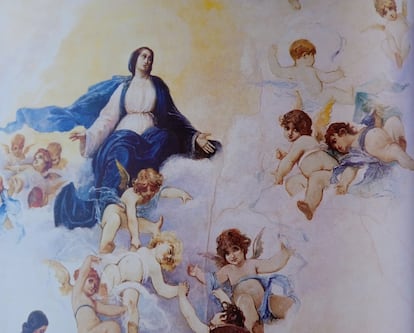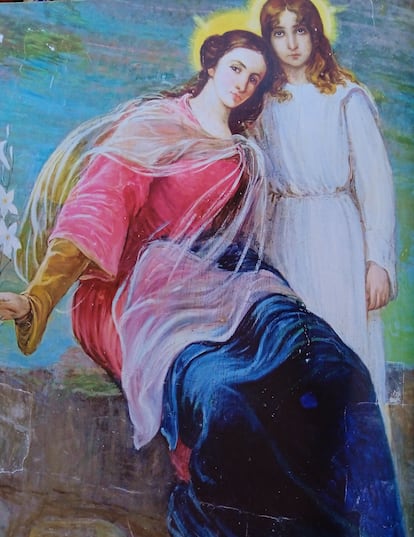The unfinished business of Julio Romero de Torres's 'Sistine Chapel'

It is considered the Sistine Chapel of the painter Julio Romero de Torres . The Cordoban artist gave the town of Porcuna (5,900 inhabitants, Jaén) some of his finest jewels, especially the religious frescoes that can be visited in the stone church of the Assumption. There are five works that have survived for more than a century: The Assumption of the Virgin on the vault of the main altar; the mural of the Last Supper in one of the chapels of the transept; the Holy Family, which is located parallel in the other chapel; a valuable oil on canvas of Saint John the Baptist in prayer, which was believed lost during the Civil War and was found in the church chambers. In addition to these works, there are four paintings of the Four Evangelists, which were not attributed to the Cordoban painter until 2017, thanks to research by historian Juan Miguel Bueno, also author of a book on Julio Romero de Torres.
"The paintings, which date back to 1908, must be restored as soon as possible, especially the two murals in the apses, both the Last Supper and the Holy Family, which are the most affected by the passage and vicissitudes of time," explains the mayor of Porcuna, Miguel Moreno. The works, which are the property of the Church, were even damaged during the Civil War, and more recently, Rafael Romero, the artist's son, carried out a flawed restoration. The mayor is requesting assistance from institutions, primarily from the Ministry of Culture of the Regional Government of Andalusia, which is responsible for conservation, for a task that, he points out, is beyond the municipality's technical and financial capabilities. He has also received no response from the Regional Government of Andalusia requesting these paintings be declared a Site of Cultural Interest (BIC) . The Andalusian government maintains that it is a property owned by the Diocese of Jaén, although it is open to collaborating in its restoration through the sacred art grant program.
However, the municipal demand for restoration has been around for a long time. Luis Emilio Vallejo, PhD in Fine Arts and municipal heritage specialist, recalls that as early as 1998, urgent work was requested on the murals due to the cracks that had appeared. In 2000, the Andalusian Regional Government restored the central vault, and later another project was commissioned to continue the restoration of two other murals severely affected by rising damp, condensation, and repainting since 1975.

A report by experts Juan Miguel Bueno and Luis E. Vallejo revealed that the mural paintings "are severely affected by damp coming from both the floor and the wall support and roof enclosure," something they described as "very serious" because it could cause "irreparable losses in a project of this nature."
One of the worst (and most difficult to recover) damages occurred with the unfortunate restoration carried out by Rafael Romero in 1975, involving repainting that altered the face of Jesus in the Last Supper. Vallejo considers it urgent to protect these unique creations with the highest legal protection, which is their declaration as a Cultural Heritage of Humanity. "Such protection would guarantee a series of protocols that would prevent the continued deterioration and irreversible loss of parts or groups of these works."
Julio Romero de Torres's pictorial output in Porcuna is not limited to religious artwork. Last October, a previously unpublished work by the Cordoba painter came to light: an oil on panel titled Portrait of a Child , dated 1903, which had been in the possession of the Gallo family. Experts believe that this painting, like others, was created by the artist during his stay in Porcuna while working on the murals in the apse of the Church of the Assumption, when he painted several portraits of the children of the Gallo family, his hosts at the time.
This work depicts the infant with a serious face, rosy cheeks, and dressed in a garment adorned with lace, a typical image of the early 20th century. For Jesús Aguilar Díaz, a researcher at the University of Seville and author of this recent discovery, this work confirms the breadth of portraiture by Julio Romero de Torres, who worked for the bourgeoisie of Madrid and Cordoba, with women as his main muse. Experts compare the painting to others of similar characteristics by the artist himself, such as Andalusian Pereza or Sánchez Bendición , characterized by their great luminosity and color.

Meanwhile, and as a culmination of the events of the 150th anniversary of the birth of Julio Romero de Torres , the City Council of Córdoba has celebrated the return to the city of the painting Rivalry , considered one of his major paintings, was purchased for €700,000. This is the first work by the artist (dated 1925) acquired by the city in the last 25 years, since the local council bought La gracia for €600,000 in 2000. Rivalry was exhibited at the 1929 Ibero-American Exposition , where it was acquired by the Argentine doctor Arturo Uriarte. In 1941, it was deposited in the Museo Nacional de Bellas Artes in Argentina, where it remained until 2002, when Sotheby's in London auctioned the painting, which was then purchased by the Prasa Foundation.
The mayor of Córdoba, José María Bellido, welcomed the return of this painting by the Cordoban genius to the municipal heritage. The mayor asserted that the events commemorating the painter's birth anniversary have "left behind clichés and stereotypes" about the artist. " Rivalidad ," which can now be seen in Room VI of the Julio Romero de Torres Museum , among two other major works by the artist, La chiquita piconera (The Little Piconera) and La Gracia (Grace) , depicts two women vying for the attention of a man, symbolized by a Cordoban hat. The models were Margarita Goudoun, a Russian flamenco dancer, and the French model Asunción Vouet.
The director of the Julio Romero de Torres Museum, Enrique Ortega, has detailed that the work is in "radiant" condition. A painting, Ortega noted, that Romero de Torres valued it highly, to the point that in the insurance policy taken out for the Ibero-American Exposition, it was valued much more highly than The Little Piconera .
EL PAÍS


%3Aformat(jpg)%3Aquality(99)%3Awatermark(f.elconfidencial.com%2Ffile%2Fbae%2Feea%2Ffde%2Fbaeeeafde1b3229287b0c008f7602058.png%2C0%2C275%2C1)%2Ff.elconfidencial.com%2Foriginal%2F56e%2Fe15%2Ffba%2F56ee15fba84cb59a1510c7a7e8ce8758.jpg&w=3840&q=100)


